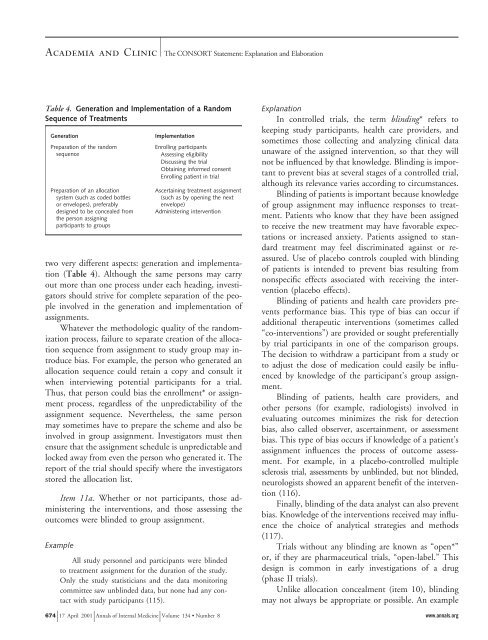The Revised CONSORT Statement for Reporting Randomized Trials
The Revised CONSORT Statement for Reporting Randomized Trials
The Revised CONSORT Statement for Reporting Randomized Trials
You also want an ePaper? Increase the reach of your titles
YUMPU automatically turns print PDFs into web optimized ePapers that Google loves.
Academia and Clinic <strong>The</strong> <strong>CONSORT</strong> <strong>Statement</strong>: Explanation and Elaboration<br />
Table 4. Generation and Implementation of a Random<br />
Sequence of Treatments<br />
Generation Implementation<br />
Preparation of the random<br />
sequence<br />
Preparation of an allocation<br />
system (such as coded bottles<br />
or envelopes), preferably<br />
designed to be concealed from<br />
the person assigning<br />
participants to groups<br />
two very different aspects: generation and implementation<br />
(Table 4). Although the same persons may carry<br />
out more than one process under each heading, investigators<br />
should strive <strong>for</strong> complete separation of the people<br />
involved in the generation and implementation of<br />
assignments.<br />
Whatever the methodologic quality of the randomization<br />
process, failure to separate creation of the allocation<br />
sequence from assignment to study group may introduce<br />
bias. For example, the person who generated an<br />
allocation sequence could retain a copy and consult it<br />
when interviewing potential participants <strong>for</strong> a trial.<br />
Thus, that person could bias the enrollment* or assignment<br />
process, regardless of the unpredictability of the<br />
assignment sequence. Nevertheless, the same person<br />
may sometimes have to prepare the scheme and also be<br />
involved in group assignment. Investigators must then<br />
ensure that the assignment schedule is unpredictable and<br />
locked away from even the person who generated it. <strong>The</strong><br />
report of the trial should specify where the investigators<br />
stored the allocation list.<br />
Item 11a. Whether or not participants, those administering<br />
the interventions, and those assessing the<br />
outcomes were blinded to group assignment.<br />
Example<br />
Enrolling participants<br />
Assessing eligibility<br />
Discussing the trial<br />
Obtaining in<strong>for</strong>med consent<br />
Enrolling patient in trial<br />
Ascertaining treatment assignment<br />
(such as by opening the next<br />
envelope)<br />
Administering intervention<br />
All study personnel and participants were blinded<br />
to treatment assignment <strong>for</strong> the duration of the study.<br />
Only the study statisticians and the data monitoring<br />
committee saw unblinded data, but none had any contact<br />
with study participants (115).<br />
Explanation<br />
In controlled trials, the term blinding* refers to<br />
keeping study participants, health care providers, and<br />
sometimes those collecting and analyzing clinical data<br />
unaware of the assigned intervention, so that they will<br />
not be influenced by that knowledge. Blinding is important<br />
to prevent bias at several stages of a controlled trial,<br />
although its relevance varies according to circumstances.<br />
Blinding of patients is important because knowledge<br />
of group assignment may influence responses to treatment.<br />
Patients who know that they have been assigned<br />
to receive the new treatment may have favorable expectations<br />
or increased anxiety. Patients assigned to standard<br />
treatment may feel discriminated against or reassured.<br />
Use of placebo controls coupled with blinding<br />
of patients is intended to prevent bias resulting from<br />
nonspecific effects associated with receiving the intervention<br />
(placebo effects).<br />
Blinding of patients and health care providers prevents<br />
per<strong>for</strong>mance bias. This type of bias can occur if<br />
additional therapeutic interventions (sometimes called<br />
“co-interventions”) are provided or sought preferentially<br />
by trial participants in one of the comparison groups.<br />
<strong>The</strong> decision to withdraw a participant from a study or<br />
to adjust the dose of medication could easily be influenced<br />
by knowledge of the participant’s group assignment.<br />
Blinding of patients, health care providers, and<br />
other persons (<strong>for</strong> example, radiologists) involved in<br />
evaluating outcomes minimizes the risk <strong>for</strong> detection<br />
bias, also called observer, ascertainment, or assessment<br />
bias. This type of bias occurs if knowledge of a patient’s<br />
assignment influences the process of outcome assessment.<br />
For example, in a placebo-controlled multiple<br />
sclerosis trial, assessments by unblinded, but not blinded,<br />
neurologists showed an apparent benefit of the intervention<br />
(116).<br />
Finally, blinding of the data analyst can also prevent<br />
bias. Knowledge of the interventions received may influence<br />
the choice of analytical strategies and methods<br />
(117).<br />
<strong>Trials</strong> without any blinding are known as “open*”<br />
or, if they are pharmaceutical trials, “open-label.” This<br />
design is common in early investigations of a drug<br />
(phase II trials).<br />
Unlike allocation concealment (item 10), blinding<br />
may not always be appropriate or possible. An example<br />
674 17 April 2001 Annals of Internal Medicine Volume 134 • Number 8 www.annals.org
















